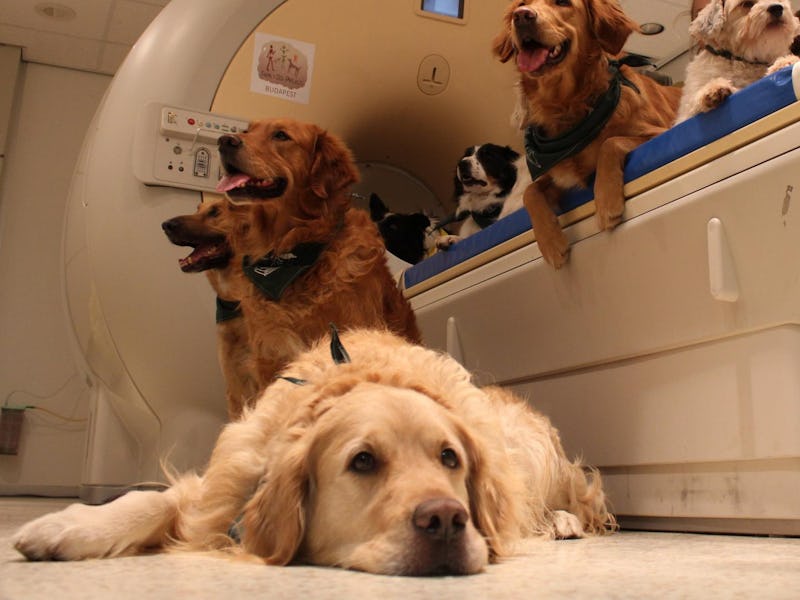Dogs surprisingly don't care about 1 part of the body as much as we thought
Dogs don't actually like your face, but that's not a bad thing.

There are few things more relaxing than staring deeply into the eyes of your canine companion, but a new study suggests dogs might not be as into our faces as we are into theirs.
Humans and primates have a demonstrated love for faces — so much so that we've evolved a whole section of our brains to process both human and non-human faces. But while previous research suggests dogs can hold eye contact and even read our emotions via our facial expressions, researchers hadn't tested whether dogs' brains were wired to prefer faces in the same way as humans'.
Now, we know. Unlike humans, primates, and even tortoises, dogs' brains react the same to a face as they do to the back of someone's head.
But don't worry: The human-dog love story isn't dead. This result may actually mean dogs love you no matter how you might look to anyone or anything else.
In the study, which was published Monday in the journal JNeurosci, researchers scanned both human and dog volunteers' brains using fMRI.
Family dogs in Hungary and Mexico were recruited for these fMRI studies.
The study was conducted across two labs — one in Hungary, and one in Mexico. The Hungary lab scanned only humans, while the Mexico lab took on the dogs and human participants. To ensure the dogs already had familiarity with human faces, the pooches recruited were all family dogs. In total, the researchers studied 30 humans and 20 dogs.
The researchers traced brain function data while both the human participants and the canine participants watched short videos of either: human faces, dog faces, the back of a human's head, or the back of a dog's head. The faces shown were neutral in expression and, in the case of human faces, didn't feature any piercings or heavy makeup. To ensure that the dogs didn't feel threatened, the dogs and humans on-screen looked away from the camera.
After completing several scans over several days, the researchers analyzed how similar — or different — the humans and dogs' brain responses appeared.
Not a face fan — Surprisingly, the researchers found dogs' brains don't have a specialized area that responds to faces, whether they be of the human or canine variety. In fact, dogs demonstrate no preference between viewing the back of a human or dog's head versus their face.
But the dogs did seem to prefer looking at other dogs as opposed to humans. This was actually something they shared with the human cohort — they too preferred their own species' faces.
But the humans' preference for any face (human or canine) was stronger than their preference for other body parts (in this case, the back of a human head). This is the inverse of what the researchers discovered about the dogs. They appear to prefer their own species first (either the front of the face or the back of the head), and not any human face.
Once in the fMRI, both dogs and humans watched a rotation of videos showing human and dog faces.
In a statement accompanying the study, first author and researcher at the Hungarian Academy of Sciences Nóra Bunford said these differences are important for planning future — and interpreting past — canine research.
"[This] demonstrates that there can be substantial dissimilarities in cortical specialization for face perception across mammals," explains Bunford. "These findings also shed new light on previous dog fMRI studies claiming to have found 'face areas:' we now think that the stronger activity to dog faces in those studies indicated dog-preferring rather than face-preferring brain areas."
Lost love? — While our pets' brains may not be wired to prefer our faces, previous research has demonstrated that pet pooches do recognize and even love their owners. Our pets may also be demonstrating their preference for us through other sensory means, like our scent or the sound of our voice.
Moral of the story? Man's best friend doesn't care what you look like and they love you all the same.
Abstract: Conspecific-preference in social perception is evident for multiple sensory modalities and in many species. There is also a dedicated neural network for face processing in primates. Yet, the evolutionary origin and the relative role of neural species-sensitivity and face-sensitivity in visuo-social processing are largely unknown. In this comparative study, species- and face sensitivity to identical visual stimuli (videos of human and dog faces and occiputs) were examined using functional magnetic resonance imaging in dogs (n=20; 45% female) and humans (n=30; 50% female). In dogs, the bilateral mid suprasylvian gyrus showed conspecific-preference, no regions exhibited face-preference, and the majority of the visually responsive cortex showed greater conspecific- than face-preference. In humans, conspecific preferring regions (the right amygdala/hippocampus and the posterior superior temporal sulcus) also showed face-preference, and much of the visually-responsive cortex showed greater face- than conspecific-preference. Multivariate pattern analyses identified species sensitive regions in both species, but face-sensitive regions only in humans. Across-species representational similarity analyses revealed stronger correspondence between dog and human response patterns for distinguishing con- from heterospecific faces than other contrasts. Results unveil functional analogies in dog and human visuo-social processing of conspecificity but suggest that cortical specialization for face perception may not be ubiquitous across mammals.
This article was originally published on